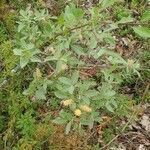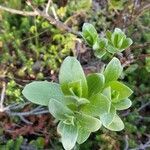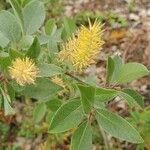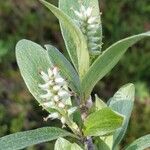Plants 0.2-6 m, not clonal. Stems erect or decumbent; branches brownish, yellow-brown, gray-brown, or red-brown, villous or pilose to glabrescent; branchlets yellow-brown or red-brown, sparsely to densely villous or tomentose to glabrescent. Leaves: stipules (marcescent or not), foliaceous or rudimentary on early and late ones; petiole (usually deeply to shallowly grooved adaxially), 1-27 mm, (much longer than subtended bud); largest medial blade usually hypostomatous, sometimes hemiamphistomatous or amphistomatous, usually narrowly elliptic, elliptic, usually oblanceolate or obovate, sometimes narrowly oblong or obovate, 27-82 × 6-39 mm, 1.4-4.8 times as long as wide, base usually cuneate or convex, sometimes rounded, rarely subcordate, margins slightly revolute or flat, usually entire, apex acute, acuminate, convex, or rounded, abaxial surface densely villous or villous-silky, tomentose, short-or long-silky, or pilose, hairs usually wavy or straight, sometimes curved, adaxial usually slightly glossy, sometimes dull, moderately densely villous, pilose, or long-silky to glabrescent; proximal blade margins entire or serrulate; juvenile blade sparsely or densely villous, tomentose, or long-silky abaxially. Catkins: staminate 14-53 × 5-17 mm, flowering branchlet 1-25 mm; pistillate densely to sometimes loosely flowered, slender, stout, subglobose, or globose, 15-83 × 7-21 mm, flowering branchlet 2-37 mm; floral bract tawny, brown, bicolor, or greenish, 1-3.4 mm, apex convex or rounded, entire, abaxially hairy, hairs wavy, crinkled, or straight. Staminate flowers: abaxial nectary 0.1-1 mm, adaxial nectary narrowly oblong, oblong, square, ovate, or flask-shaped, 0.5-1.3 mm, nectaries distinct, or connate and cup-shaped; filaments distinct or slightly or partly connate, glabrous, or hairy on proximal 1/2; anthers 0.4-0.8 mm. Pistillate flowers: abaxial nectary absent, adaxial nectary usually narrowly oblong, oblong, or ovate, sometimes flask-shaped, 0.4-1.8 mm, shorter to longer than stipe; stipe 0.3-2.8 mm; ovary pyriform or obclavate, densely villous, tomentose, short-silky, or pubescent, beak usually gradually tapering to styles, sometimes gradually tapering to or slightly bulged below styles; ovules 6-22 per ovary; styles connate to distinct 1/2 their lengths or more, 0.3-1.6 mm; stigmas flat, abaxially non-papillate with rounded tip, or slenderly or broadly cylindrical, 0.2-0.8 mm. Capsules 4.5-9 mm. 2n = 76, 95, 114, 152.
More
Shrubs to 1 m tall. Branchlets russet, glabrous or pilose. Stipules present; petiole present; leaf blade oblong-obovate, 3-5 × 1-2.5 cm, sparsely downy, abaxially grayish blue, base broadly cuneate, margin entire, apex shortly acuminate. Flowering coetaneous or serotinous. Catkins 2-4 cm; peduncle elongated in fruit; bracts long obovate, villous, apex obtuse. Male flower: stamens 2; filaments distinct, downy proximally. Female flower: ovary cylindric-ovoid, white tomentose, shortly stipitate; style deeply 2-lobed; stigma forked. Capsule 5-8 mm, gray tomentose; Fl. Jun-Jul. 2n = 76, 96, 114, 144, 152.
An erect shrub. It grows 2 m high and is smaller in alpine regions. The young twigs are softly hairy. The leaves are dark green above and paler blue-green underneath. The bracts are pale brown. The fruit are hairy capsules.





